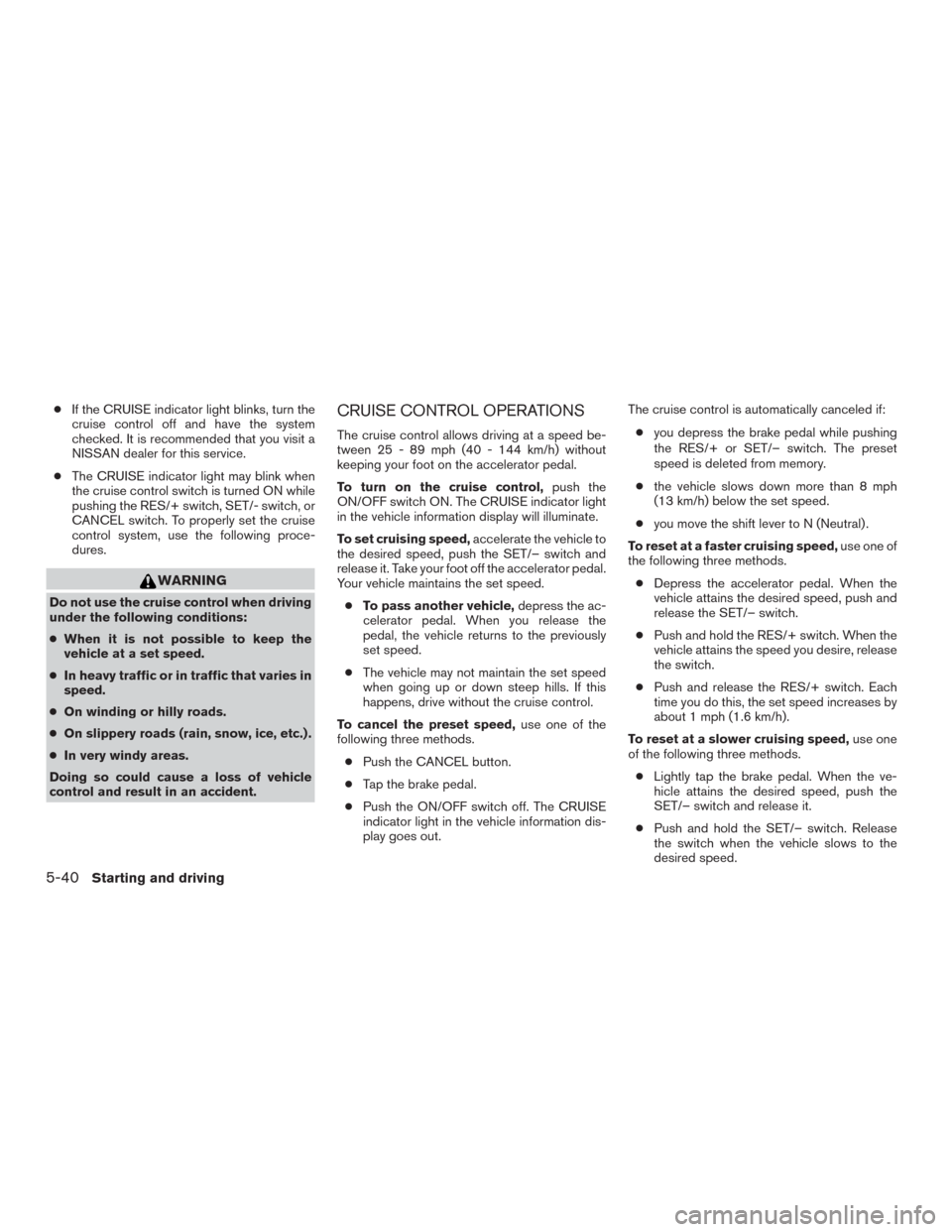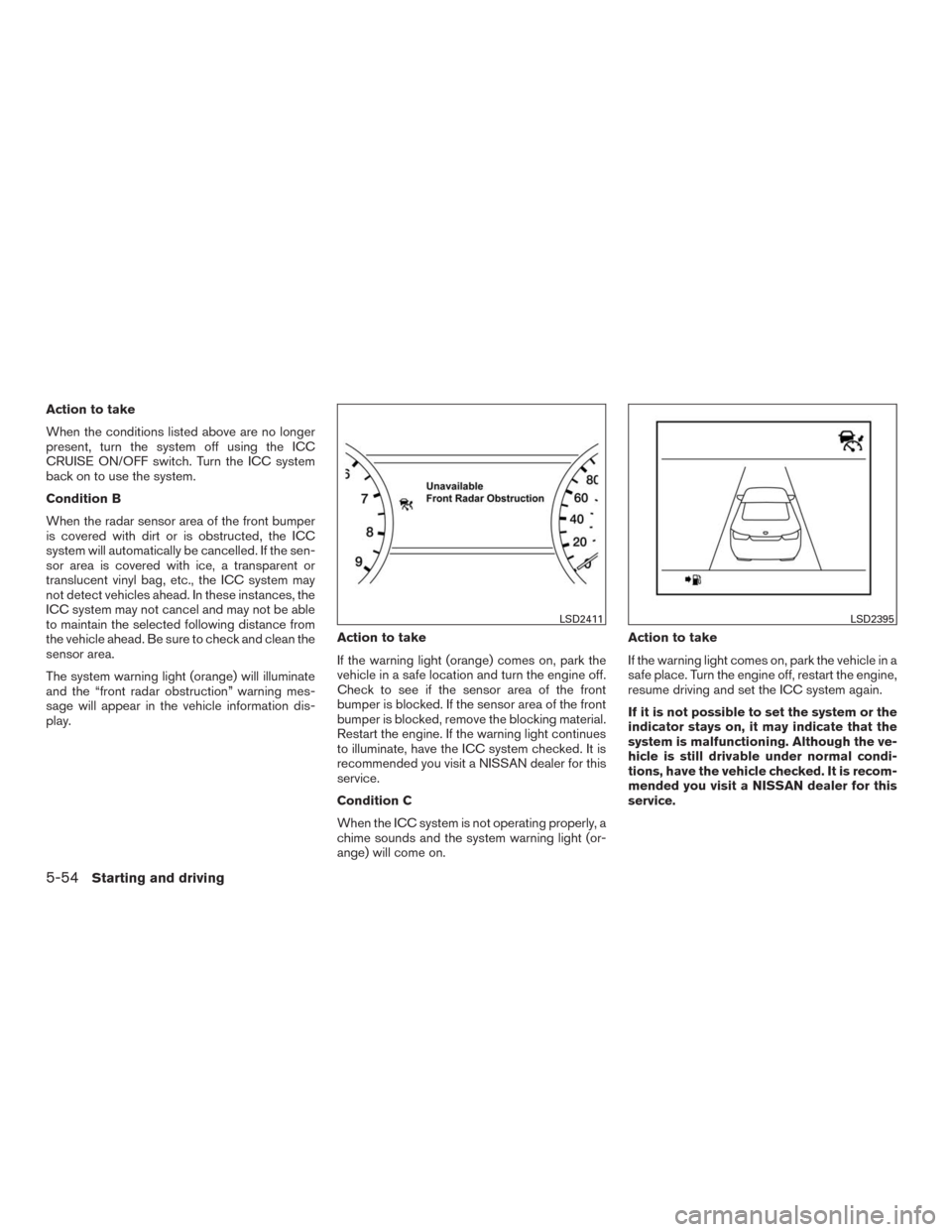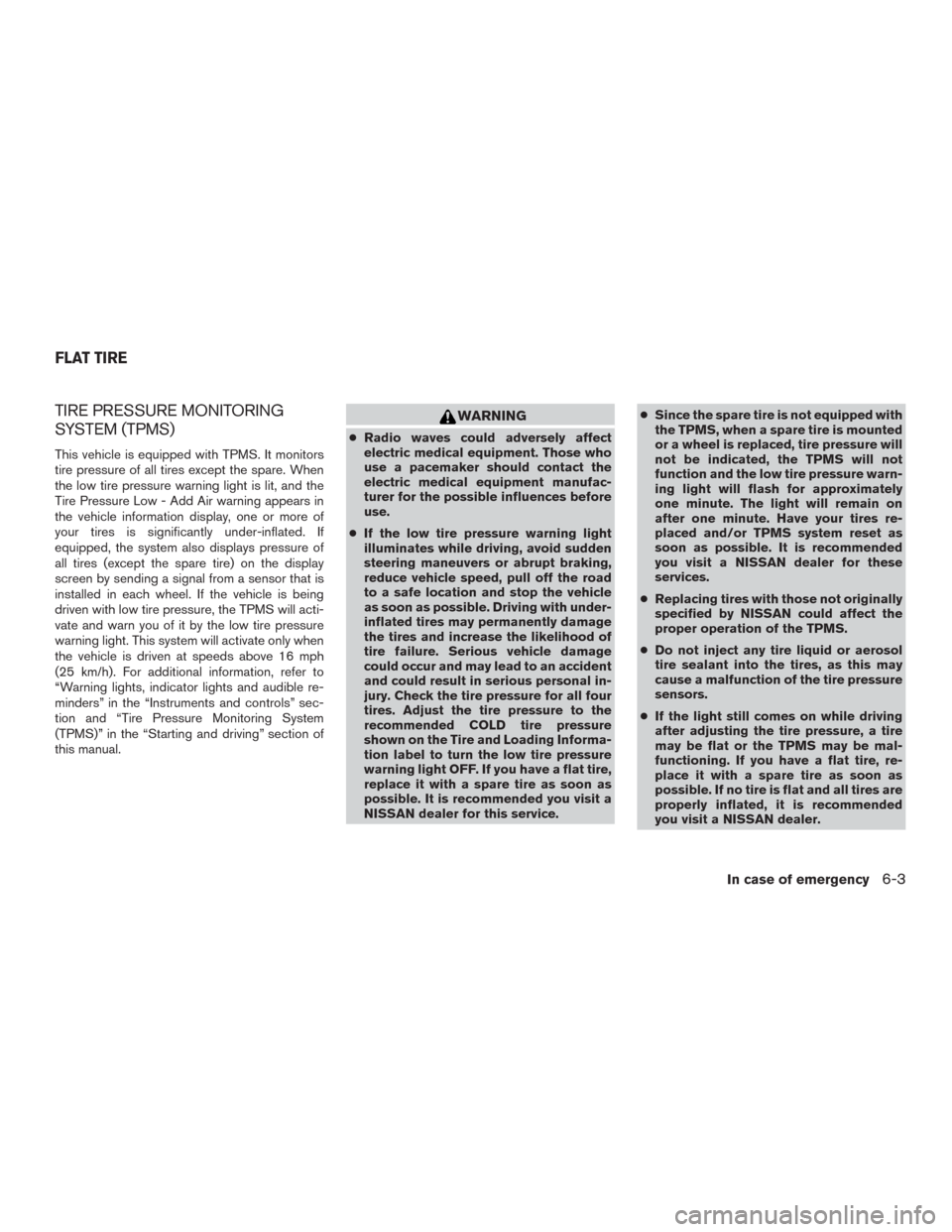2016 NISSAN MURANO service indicator
[x] Cancel search: service indicatorPage 275 of 465

5. Press the shift lever button and move the
shift lever to the N (Neutral) position while
holding down the shift lock release. The
vehicle may be moved to the desired loca-
tion. Replace the removed shift lock release
cover after the operation. If the shift lever
cannot be moved out of the P (Park) posi-
tion, have the CVT system checked as soon
as possible. It is recommended that you visit
a NISSAN dealer for this service.
WARNING
If the shift lever cannot be moved from the
P (Park) position while the engine is run-
ning and the brake pedal is depressed, the
stop lights may not work. Malfunctioning
stop lights could cause an accident injur-
ing yourself and others.
Accelerator downshift
— in D (Drive) position —
For passing or hill climbing, depress the accel-
erator pedal to the floor. This shifts the transmis-
sion down into a lower gear, depending on the
vehicle speed.
High fluid temperature protection
mode
This transmission has a high fluid temperature
protection mode. If the fluid temperature be-
comes too high (for example, when climbing
steep grades in high temperatures with heavy
loads, such as when towing a trailer) , engine
power and, under some conditions, vehicle
speed will be decreased automatically to reduce
the chance of transmission damage. Vehicle
speed can be controlled with the accelerator
pedal, but the engine and vehicle speed may be
limited.
Fail-safe
If the vehicle is driven under extreme con-
ditions, such as excessive wheel spinning
and subsequent hard braking, the fail-safe
system may be activated. The Malfunction
Indicator Light (MIL) may come on to indi-
cate the fail-safe mode is activated. For
additional information, refer to “Malfunc-
tion Indicator Light (MIL)” in the “Instru-
ment and controls” section of this manual.
This will occur even if all electrical circuits
are functioning properly. In this case, place
the ignition switch in the OFF position and
wait for 10 seconds. Then push the switch
back to the ON position. The vehicle should
return to its normal operating condition. Ifit does not return to its normal operating
condition, have the transmission checked
and repaired, if necessary. It is recom-
mended that you visit a NISSAN dealer for
this service.
WARNING
When the high fluid temperature protec-
tion mode or fail-safe operation occurs,
vehicle speed may be gradually reduced.
The reduced speed may be lower than
other traffic, which could increase the
chance of a collision. Be especially careful
when driving. If necessary, pull to the side
of the road at a safe place and allow the
transmission to return to normal opera-
tion, or have it repaired if necessary.
5-20Starting and driving
Page 295 of 465

●If the CRUISE indicator light blinks, turn the
cruise control off and have the system
checked. It is recommended that you visit a
NISSAN dealer for this service.
●The CRUISE indicator light may blink when
the cruise control switch is turned ON while
pushing the RES/+ switch, SET/- switch, or
CANCEL switch. To properly set the cruise
control system, use the following proce-
dures.
WARNING
Do not use the cruise control when driving
under the following conditions:
●When it is not possible to keep the
vehicle at a set speed.
●In heavy traffic or in traffic that varies in
speed.
●On winding or hilly roads.
●On slippery roads (rain, snow, ice, etc.) .
●In very windy areas.
Doing so could cause a loss of vehicle
control and result in an accident.
CRUISE CONTROL OPERATIONS
The cruise control allows driving at a speed be-
tween 25 - 89 mph (40 - 144 km/h) without
keeping your foot on the accelerator pedal.
To turn on the cruise control,push the
ON/OFF switch ON. The CRUISE indicator light
in the vehicle information display will illuminate.
To set cruising speed,accelerate the vehicle to
the desired speed, push the SET/– switch and
release it. Take your foot off the accelerator pedal.
Your vehicle maintains the set speed.
●To pass another vehicle,depress the ac-
celerator pedal. When you release the
pedal, the vehicle returns to the previously
set speed.
●The vehicle may not maintain the set speed
when going up or down steep hills. If this
happens, drive without the cruise control.
To cancel the preset speed,use one of the
following three methods.
●Push the CANCEL button.
●Tap the brake pedal.
●Push the ON/OFF switch off. The CRUISE
indicator light in the vehicle information dis-
play goes out.The cruise control is automatically canceled if:
●you depress the brake pedal while pushing
the RES/+ or SET/– switch. The preset
speed is deleted from memory.
●the vehicle slows down more than 8 mph
(13 km/h) below the set speed.
●you move the shift lever to N (Neutral) .
To reset at a faster cruising speed,use one of
the following three methods.
●Depress the accelerator pedal. When the
vehicle attains the desired speed, push and
release the SET/– switch.
●Push and hold the RES/+ switch. When the
vehicle attains the speed you desire, release
the switch.
●Push and release the RES/+ switch. Each
time you do this, the set speed increases by
about 1 mph (1.6 km/h).
To reset at a slower cruising speed,use one
of the following three methods.
●Lightly tap the brake pedal. When the ve-
hicle attains the desired speed, push the
SET/– switch and release it.
●Push and hold the SET/– switch. Release
the switch when the vehicle slows to the
desired speed.
5-40Starting and driving
Page 309 of 465

Action to take
When the conditions listed above are no longer
present, turn the system off using the ICC
CRUISE ON/OFF switch. Turn the ICC system
back on to use the system.
Condition B
When the radar sensor area of the front bumper
is covered with dirt or is obstructed, the ICC
system will automatically be cancelled. If the sen-
sor area is covered with ice, a transparent or
translucent vinyl bag, etc., the ICC system may
not detect vehicles ahead. In these instances, the
ICC system may not cancel and may not be able
to maintain the selected following distance from
the vehicle ahead. Be sure to check and clean the
sensor area.
The system warning light (orange) will illuminate
and the “front radar obstruction” warning mes-
sage will appear in the vehicle information dis-
play.Action to take
If the warning light (orange) comes on, park the
vehicle in a safe location and turn the engine off.
Check to see if the sensor area of the front
bumper is blocked. If the sensor area of the front
bumper is blocked, remove the blocking material.
Restart the engine. If the warning light continues
to illuminate, have the ICC system checked. It is
recommended you visit a NISSAN dealer for this
service.
Condition C
When the ICC system is not operating properly, a
chime sounds and the system warning light (or-
ange) will come on.Action to take
If the warning light comes on, park the vehicle in a
safe place. Turn the engine off, restart the engine,
resume driving and set the ICC system again.
If it is not possible to set the system or the
indicator stays on, it may indicate that the
system is malfunctioning. Although the ve-
hicle is still drivable under normal condi-
tions, have the vehicle checked. It is recom-
mended you visit a NISSAN dealer for this
service.
LSD2411LSD2395
5-54Starting and driving
Page 348 of 465

TIRE PRESSURE MONITORING
SYSTEM (TPMS)
This vehicle is equipped with TPMS. It monitors
tire pressure of all tires except the spare. When
the low tire pressure warning light is lit, and the
Tire Pressure Low - Add Air warning appears in
the vehicle information display, one or more of
your tires is significantly under-inflated. If
equipped, the system also displays pressure of
all tires (except the spare tire) on the display
screen by sending a signal from a sensor that is
installed in each wheel. If the vehicle is being
driven with low tire pressure, the TPMS will acti-
vate and warn you of it by the low tire pressure
warning light. This system will activate only when
the vehicle is driven at speeds above 16 mph
(25 km/h). For additional information, refer to
“Warning lights, indicator lights and audible re-
minders” in the “Instruments and controls” sec-
tion and “Tire Pressure Monitoring System
(TPMS)” in the “Starting and driving” section of
this manual.
WARNING
●Radio waves could adversely affect
electric medical equipment. Those who
use a pacemaker should contact the
electric medical equipment manufac-
turer for the possible influences before
use.
●If the low tire pressure warning light
illuminates while driving, avoid sudden
steering maneuvers or abrupt braking,
reduce vehicle speed, pull off the road
to a safe location and stop the vehicle
as soon as possible. Driving with under-
inflated tires may permanently damage
the tires and increase the likelihood of
tire failure. Serious vehicle damage
could occur and may lead to an accident
and could result in serious personal in-
jury. Check the tire pressure for all four
tires. Adjust the tire pressure to the
recommended COLD tire pressure
shown on the Tire and Loading Informa-
tion label to turn the low tire pressure
warning light OFF. If you have a flat tire,
replace it with a spare tire as soon as
possible. It is recommended you visit a
NISSAN dealer for this service.●Since the spare tire is not equipped with
the TPMS, when a spare tire is mounted
or a wheel is replaced, tire pressure will
not be indicated, the TPMS will not
function and the low tire pressure warn-
ing light will flash for approximately
one minute. The light will remain on
after one minute. Have your tires re-
placed and/or TPMS system reset as
soon as possible. It is recommended
you visit a NISSAN dealer for these
services.
●Replacing tires with those not originally
specified by NISSAN could affect the
proper operation of the TPMS.
●Do not inject any tire liquid or aerosol
tire sealant into the tires, as this may
cause a malfunction of the tire pressure
sensors.
●If the light still comes on while driving
after adjusting the tire pressure, a tire
may be flat or the TPMS may be mal-
functioning. If you have a flat tire, re-
place it with a spare tire as soon as
possible. If no tire is flat and all tires are
properly inflated, it is recommended
you visit a NISSAN dealer.
FLAT TIRE
In case of emergency6-3
Page 391 of 465

If the brakes do not operate properly, have the
brakes checked by a NISSAN dealer.
Self-adjusting brakes
Your vehicle is equipped with self-adjusting
brakes.
The front and rear disc-type brakes self-adjust
every time the brake pedal is applied.
WARNING
Have your brake system checked if the
brake pedal height does not return to nor-
mal. It is recommended that you visit a
NISSAN dealer for this service.
Brake pad wear indicators
The disc brake pads on your vehicle have audible
wear indicators. When a brake pad requires re-
placement, a high pitched scraping or screech-
ing sound will be heard when the vehicle is in
motion. The noise will be heard whether or not the
brake pedal is depressed. Have the brakes
checked as soon as possible if the wear indicator
sound is heard.
Under some driving or climate conditions, occa-
sional brake squeak, squeal or other noise may
be heard. Occasional brake noise during light to
moderate stops is normal and does not affect the
function or performance of the brake system.Proper brake inspection intervals should
be followed.For additional information regard-
ing brake inspections, refer to the appropriate
maintenance schedule information in the
“NISSAN Service and Maintenance Guide”.
If any electrical equipment does not operate,
check for an open fuse.
Fuses are used in the passenger and engine
compartment. Spare fuses are provided and can
be found in the passenger compartment fuse
box.
When installing a fuse make sure the fuse is
installed in the fuse box securely.
LDI2385
BRAKESFUSES
8-22Maintenance and do-it-yourself
Page 409 of 465

●The original tires have built-in
tread wear indicators. When the
wear indicators are visible, the
tire(s) should be replaced.
●Tires degrade with age and use.
Have tires, including the spare,
over 6 years old checked by a
qualified technician because
some tire damage may not be ob-
vious. Replace the tires as neces-
sary to prevent tire failure and
possible personal injury.
●Improper service of the spare tire
may result in serious personal in-
jury. If it is necessary to repair the
spare tire, it is recommended that
you visit a NISSAN dealer for this
service.
●For additional information re-
garding tires, refer to “Important
Tire Safety Information” (US) or
“Tire Safety Information”
(Canada) in the Warranty Infor-
mation Booklet.Replacing wheels and tires
When replacing a tire, use the same size, tread
design, speed rating and load carrying capacity
as originally equipped. For additional information,
refer to “Wheels and tires” in the “Technical and
consumer information” section of this manual.
WARNING
●The use of tires other than those recom-
mended or the mixed use of tires of
different brands, construction (bias,
bias-belted or radial) , or tread patterns
can adversely affect the ride, braking,
handling, VDC system, ground clear-
ance, body-to-tire clearance, tire chain
clearance, speedometer calibration,
headlight aim and bumper height.
Some of these effects may lead to acci-
dents and could result in serious per-
sonal injury.
●For 2WD models, if your vehicle was
originally equipped with 4 tires that
were the same size and you are only
replacing 2 of the 4 tires, install the new
tires on the rear axle. Placing new tires
on the front axle may cause loss of
vehicle control in some driving condi-
tions and cause an accident and per-
sonal injury.●If the wheels are changed for any rea-
son, always replace with wheels which
have the same off-set dimension.
Wheels of a different off-set could
cause premature tire wear, degrade ve-
hicle handling characteristics, affect the
VDC system and/or interference with
the brake discs. Such interference can
lead to decreased braking efficiency
and/or early brake pad wear. For addi-
tional information on wheel off-set di-
mensions, refer to “Wheels and tires” in
the “Technical and consumer informa-
tion” section of this manual.
●Since the spare tire is not equipped with
the TPMS, when a spare tire is mounted
or a wheel is replaced, tire pressure will
not be indicated, the TPMS will not
function and the low tire pressure warn-
ing light will flash for approximately
1 minute. The light will remain on after
1 minute. Have your tires replaced
and/or TPMS system reset as soon as
possible. It is recommended you visit a
NISSAN dealer for this service.
●Replacing tires with those not originally
specified by NISSAN could affect the
proper operation of the TPMS.
8-40Maintenance and do-it-yourself
Page 447 of 465

Seats
Adjustment...................1-2
Armrests....................1-7
Automatic drive
positioner........3-35,3-36,3-37,3-38
Frontseats...................1-2
Heatedseats.............2-37,2-40
Manual front seat adjustment.........1-3
Rear seat....................1-6
Seats/floor mats..................7-4
Security indicator light..............2-14
Security system (NISSAN Vehicle Immobilizer
System) , engine start...........2-28,5-14
Security systems
Vehicle security system...........2-27
Self-adjusting brakes..............8-22
Service manual order form...........9-30
Servicing air conditioner.............4-29
Shoulder belt height adjustment........1-23
Spark plug replacement.............8-18
Spark plugs...................8-18
Specifications...................9-8
Speedometer...................2-4
Speedometer and odometer...........2-4
Spotlights(Seemaplight) ...........2-55
SRS warning label................1-66
Starting
Before starting the engine..........5-14
Jump starting..............6-9,8-17
Precautions when starting and
driving...................5-2,5-9
Push starting.................6-11
Starting the engine.............5-15
Starting the engine...............5-15
Steering
Heated steering wheel...........2-40Power steering fluid.............8-14
Power steering system...........5-82
Steeringwheel..................3-30
Stoplight.....................8-29
Storage......................2-43
Storage tray...................2-44
Sunglassescase.................2-45
Sunglassesholder................2-45
Sunroof......................2-52
Sunroof(seeMoonroof).............2-52
Sun visors....................3-32
Supplemental air bag warning labels......1-66
Supplemental air bag warning light . . .1-67, 2-13
Supplemental front impact air bag system . . .1-55
Supplemental restraint system
Information and warning labels.......1-66
Precautions on supplemental restraint
system....................1-47
Supplemental restraint system
(Supplemental air bag system).........1-47
Switch
Autolightswitch...............2-33
Automatic power window switch......2-51
Foglightswitch ...............2-36
Hazard warning flasher switch........6-2
Headlight and turn signal switch......2-32
Headlight control switch..........2-32
Instrument brightness control........2-35
Power door lock switch............3-6
Rear window and outside mirror defroster
switch.....................2-32
Rear window wiper and washer
switches...................2-31
Steering wheel switch for audio
control/Bluetooth® Hands-Free Phone
System....................4-48Turnsignalswitch..............2-35
Vehicle dynamic control (VDC) off
switch.....................2-40
T
Tachometer....................2-5
Temperature gauge
Engine coolant temperature gauge.....2-6
Theft (NISSAN Vehicle Immobilizer System) ,
engine start................2-28,5-14
Three-way catalyst
................5-2
Tire
Flat tire.....................6-3
Spare tire................6-5,8-41
Tire and Loading Information label.....9-12
Tire chains..................8-38
Tire pressure.................8-31
Tire rotation..................8-39
Types of tires.................8-37
Uniform tire quality grading.........9-27
Wheels and tires............8-31,9-9
Wheel/tire size.................9-9
Tirepressure...................8-31
Low tire pressure warning light.......2-10
Tire Pressure Monitoring System (TPMS)....5-3
Top tether strap child restraint.........1-31
Towing
Flattowing..................9-26
Towing load/specification..........9-21
Towtrucktowing...............6-12
Trailer towing.................9-17
Towing a trailer..................9-17
10-6